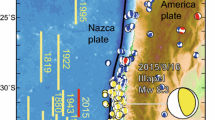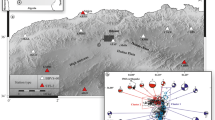Abstract
Historically, large and potentially hazardous earthquakes have occurred within the interior of Alaska. However, most have not been adequately studied using modern methods of waveform modeling. The 22 July 1937, 16 October 1947, and 7 April 1958 earthquakes are three of the largest events known to have occurred within central Alaska (M s =7.3,M s =7.2 andM s =7.3, respectively). We analyzed teleseismic body waves to gain information about the focal parameters of these events. In order to deconvolve the source time functions from teleseismic records, we first attempted to improve upon the published focal mechanisms for each event. Synthetic seismograms were computed for different source parameters, using the reflectivity method. A search was completed which compared the hand-digitized data with a suite of synthetic traces covering the complete parameter space of strike, dip, and slip direction. In this way, the focal mechanism showing the maximum correlation between the observed and calculated traces was found. Source time functions, i.e., the moment release as a function of time, were then deconvolved from teleseismic records for the three historical earthquakes, using the focal mechanisms which best fit the data. From these deconvolutions, we also recovered the depth of the events and their seismic moments. The earthquakes were all found to have a shallow foci, with depths of less than 10 km.
The 1937 earthquake occurred within a northeast-southwest band of seismicity termed the Salcha seismic zone (SSZ). We confirm the previously published focal mechanism, indicating strike-slip faulting, with one focal plane parallel to the SSZ which was interpreted as the fault plane. Assuming a unilateral fault model and a reasonable rupture velocity of between 2 and 3 km/s, the 21 second rupture duration for this event indicates that all of the 65 km long SSZ may have ruptured during this event. The 1947 event, located to the south of the northwest-southeast trending Fairbanks seismic zone, was found to have a duration of about 11 seconds, thus indicating a rupture length of up to 30 km. The rupture duration of the 1958 earthquake, which occurred near the town of Huslia, approximately 400 km ENE of Fairbanks, was found to be about 9 seconds. This gives a rupture length consistent with the observed damage, an area of 16 km by 64 km.
Similar content being viewed by others
References
Abe, K. (1981).Magnitudes of Large Shallow Earthquakes from 1904–1980, Phys. Earth Planet. Interiors27, 72–92.
Adkins, J. N. (1939),The Alaskan Earthquake of July 22, 1937, Bull. Seismol. Soc. Am.30, 353–376.
Beaudoin, B. C., Fuis, G. S., Mooney, W. D., Nokleberg, W. J., andChristensen, N. I. (1992),Thin Low-velocity Crust Beneath the Southern Yukon-Tanana Terrane, East Central Alaska: Results from Trans-Alaska Crustal Transect Refraction/Wide-angle Reflection Data, J. Geophys. Res.97, 1921–1942.
Beisser, M., andKind, R. (1988),The Reflectivity Method for SH-waves and for Different Structures at Source and Receiver Sites, Geol. J. E42, 137–142.
Beisser, M., Wyss, M., andKind, R. (1990),Inversion of Source Parameters for Subcrustal Earthquakes in the Hellenic Arc, Geophys. J. Int.103, 439–450.
Beisser, M. D., Gillard, D., andWyss, M. (1994),Inversion for Source Parameters from Sparse Da Sets: Test of the Method and Application to the 1951 (M=6.9) Kona, Hawaii, Earthquake, J. Geophys. Res.99, 19661–19678.
Biswas, N. N., Aki, K., Pulpan, H., andTytgat, G. (1986),Characteristics of Regional Stresses in Alaska and Neighboring Areas, Geophys. Res. Lett.13, 177–180.
Biswas, N. N., andTytgat, G. (1988),Intraplate Seismicity in Alaska, Seismol. Res. Lett.59, 227–233.
Bramhall, E. H. (1938),The Central Alaskan Earthquake of July 22 (1937), Bull. Seismol. Soc. Am.28, 71–75.
Brogan, G. E., Cluff, L. S., Korringa, M. K., andSlemmons, D. B. (1975),Active Faults of Alaska, Tectonophysics29, 73–85.
Bruestle, E., andMüller, G. (1983),Moment and Duration of Shallow Earthquakes from Love-wave Modelling for Regional Distances, Phys. Earth Planet. Interiors32, 312–324.
Christensen, D. H., andRuff, L. J. (1985),Analysis of the Trade-off between Hypocentral Depth and Source Time Function, Bull. Seismol. Soc. Am.75, 1637–1656.
Cluff, L. S., Slemmons, D. B., Brogan, G. E., andKorringa, M. K. (1974),Basis for Pipeline Design for Active-fault Crossings for the Trans-Alaska Pipeline System, Houston, Texas, Alyeska Pipeline Service Company, 115.
Davies, J. N. (1983),Seismicity of the Interior of Alaska — A Direct Result of Pacific-North American Plate Convergence? (abstract), EOS64, 90.
Davis, T. N. (1960),A Field Report on the Alaska Earthquakes of April 7, 1958, Bull. Seismol. Soc. Am.50, 489–510.
Dziewonski, A. M., andAnderson, D. L. (1981),Preliminary Reference Earth Model, Phys. Earth Planet. Interiors25, 297–356.
Eastabrook, C. H., Stone, D. B., andDavies, J. N. (1988),Seismotectonics of Northern Alaska, J. Geophys. Res.93, 12026–12040.
Estabrook, C. H., andBoyd, T. M. (1992),The Shumagin Islands, Alaska, Earthquake of 31 May 1917, Bull. Seismol. Soc. Am.82, 755–774.
Gedney, L., andBerg, E. (1969),The Fairbanks, Alaska Earthquakes of June 21, 1967; Aftershock Distribution, Focal Mechanisms and Crustal Parameters, Bull. Seismol. Soc. Am.59, 73–100.
Gedney, L. D., Estes, S., andBiswas, N. (1980),Earthquake Migration in the Fairbanks, Alaska Seismic Zone, Bull. Seismol. Soc. Am.70, 223–241.
Gedney, L., andMarshall, D. (1981),A Rare Earthquake Sequence in the Kobuk Trench, Northwestern Alaska, Bull. Seismol. Soc. Am.71, 1587–1592.
Geller, R. J. (1976),Body Force Equivalents for Stress-drop Seismic Sources, Bull. Seismol. Soc. Am.66, 1801–1804.
Griscom, A. (1976),Aeromagnetic Map and the Interpretation of the Tanacross Quadrangle, Alaska, U.S. Geological Survey Miscellaneous Field Studies Map MF-767A, scale 1:250,000, 2 sheets.
Hodgson, J. H., andMilne, W. G. (1951),Direction of Faulting in Certain Earthquakes of the North Pacific, Bull. Seismol. Soc. Am.41, 221–242.
Lahr, J. C., Page, R. A., Stephens, C. D., andChristensen, D. H. (1988),Unusual Earthquakes in the Gulf of Alaska and Fragmentation of the Pacific Plate, Geophys. Res. Lett.15, 1483–1486.
Macelwane, J. B., andSohon, F. W.,Introduction to Theoretical Seismology. Part II. Seismometry (Wiley, New York 1932) 149 pp.
Müller, G. (1985),The Reflectivity Method: A tutorial, J. Geophys.58, 153–174.
Nokleberg, W. J., Aleinikoff, J. N., Lange, I. M., Silva, S. R., Miyaoka, R. T., Schwab, C. E., andZehner, R. E. (1992),Preliminary Geologic Map of the Mount Hayes Quadrangle, Eastern Alaska Range, Alaska, U.S. Geological Survey Open-File Report 92-594, scale 1:250,000, 39.
Page, R. A., Plafker, G., Davies, J. N., andPulpan, H. (1989),Block Rotation and Seismicity in East-central Alaska (abstract), EOS70, 1337.
Page, R. A., Biswas, N. N., Lahr, J. C., andPulpan, H.,Seismicity of continental Alaska. InNeotectonics of North America (eds. Slemmons, D. B., Engdahl, E. R., Zoback, M. D., and Blackwell, D.) (Geological Society of America, Decade Map Volume 1 1991) pp. 47–66.
Page, R. A., Plafker, G., andPulpan, H. (1995),Block Rotation in East-central Alaska: A Framework for Evaluating Earthquake Potential? Geology23, 629–632.
Pewe, T. L., Wahrhaftig, C., andWeber, F. (1966),Geologic Map of the Fairbanks Quadrangle, Alaska, U.S. Geological Survey Miscellaneous Geologic Investigations Map I-455, scale 1:250,000.
Poppe, B. B. (1979),Historical Survey of U.S. Seismograph Stations, U.S. Geological Survey Professional Paper 1906.
Reiser, L. (1990),A Source Mechanism for the 7 April 1958 Huslia, Alaska Earthquake, Third Keck Research Symposium in Geology, Abstracts Volume.
Ruff, L., andKanamori, H. (1983),The Rupture Process and Asperity Distribution of Three Great Earthquakes from Long-period Diffracted P Waves, Phys. Earth Planet. Interiors31, 202–230.
Seidl, D. (1980),The Simulation Problem for Broad-band Seismograms, J. Geophys.48, 84–93.
Sieh, K. E.,A review of geological evidence for recurrence times of large earthquakes. InEarthquake Prediction — An International Review (eds. Simpson, D. W., and Richards, P. G.), Maurice Ewing Series, vol. 4 (American Geophysical Union, Washington, D.C. 1981), pp. 181–207.
St. Amand, P. (1948),The Central Alaska Earthquake Swarm of October 1947, Trans., AGU29, 613–623.
Wickens, A. J., andHodgson, J. H. (1967),Computer Re-evaluation of Earthquake Mechanism Solutions, 1922–1962, Dept. of Energy, Mines and Resources, Canada, Vol. XXXIII.
Author information
Authors and Affiliations
Rights and permissions
About this article
Cite this article
Fletcher, H.J., Christensen, D.H. A determination of source properties of large intraplate earthquakes in Alaska. PAGEOPH 146, 21–41 (1996). https://doi.org/10.1007/BF00876668
Received:
Revised:
Accepted:
Issue Date:
DOI: https://doi.org/10.1007/BF00876668




